Porcelain Insulator News
by Elton Gish
Reprinted from "Crown Jewels of the Wire", May 1999, page 9
In the last PIN column (CJ: March 1999), Bob Kay reported a white
U-400B with
under-glaze ink "Line Material" and "Triangle M" markings.
After reading that report, Stanley Klein (NIA #5372) reported that he has a
white U-399B with the same double marking (black under-glaze ink). In addition
to the two markings there is the under-glaze ink marking "696". All
three of the markings are right next to each other extending about 1-1/2 inches.
The brown U-399B shown in the advertisement (CJ: March 1999) was the "No.
695 Loop Insulator". The slightly different catalog number could either
indicate glaze color or pinhole size depending on the manufacturer. We do not
have any way to know which is the case with U-399B. We do know that these two
insulators were made circa 1928.
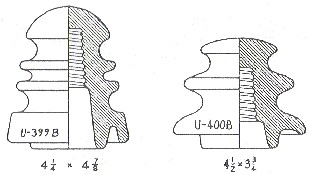
Bill Ostrander (NIA #6306) reported finding pieces of an interesting
suspension insulator. He writes: "Around Christmas of 1998, I did some
exploring of the old power line from Roosevelt Dam to Mesa, AZ. Roosevelt Dam
was finished in 1911, so it seemed like a good place to find some old glass or
porcelain. Roosevelt dam is the worlds tallest masonry dam, and was a cool
looking dam until it was extended and "prettied up" in 1996. There are
three sets of power lines running from the dam area. One was built around 1960, and one is newer, I believe. The oldest looking one has steel girder
poles with wood crossarms. They look like they were designed for suspension
insulators. The suspension insulators in use now are brown Ohio Brass, brown
Westinghouse, and gray Victors. I found a piece of one of the gray Victors that
had the large VICTOR insulator logo with R=oo marking struck between the outer
petticoat and the edge of the insulator. It also had a large incuse
"P" to the right of the logo marking. Jack Tod's book, Porcelain
Insulator Guide Book, stated that Locke used the large Victor insulator logo
marking from 1908 to late 1910's. So, the logo marking indicates that these
insulators were made around the time the dam was finished and they could be
original installation. I had always thought that the cap and pin type of
suspensions were from the early 1930's or so?"
The cap and pin design
originated quite early. The 1908 John Duncan patent was a cap and pin design
made up of two porcelain shells cemented together with Portland cement. Fred
Locke had perhaps the earliest cap and pin design for a one-piece suspension
disk which he patented in 1910 (see page 282 in my book, Fred M. Locke: A
Biography). This was patent No. 973,204 for a modern looking suspension disk
insulator with metal cap and pin but without the usual petticoats underneath.
Locke and other manufacturers soon developed various designs for a
"modern-looking" cap and pin suspension insulator with petticoats.
Problems quickly arose with the cement joint that held the metal cap and pin and
resulted in a lot of failures. The metal cap and pin would simply pull off under
the weight of the suspended conductor allowing the conductor to drop to the
ground. The once popular cementless Hewlett design quickly regained popularity.
At least if the Hewlett was broken, the interlocking nature of the linkage
prevented the conductor from dropping to the ground. It took many years for
manufacturers to resolve the cement problems that prevented the cap and pin
suspension disk achieving acceptable trouble-free service.
The gray cap and pin
suspension insulators Bill observed at the dam site were probably the ones used
for the original installation. The 1910 Locke catalog shows this specific 10-inch
diameter suspension insulator (see illustration) matching every detail down to
the cap and pin design. I have heard earlier reports of the gray Victor
suspension insulators from collectors out west. I recently obtained two.
suspension insulators that were originally in Lu Farin' s collection. One has a
reddish brown glaze and the other has a pretty bluish-gray glaze. Both
insulators have the same large Victor insulator logo marking except the incuse
"P" is to the left of the logo marking on the bluish-gray insulator
and to the right of the logo on the reddish brown insulator.
In 1995, Matt Price reported a string of five brown 10-inch suspension
insulators with the large Victor logo marking (without the letter code). It came
from the old Pacific Power and Light fine near Kennewick, WA. The metal
hardware on the suspension string was even prominently marked VICTOR. Lu
and her husband actively collected insulators across the west in the
1970's. The gray one from Lu Farin's collection may have been one that was used
at the Roosevelt dam.
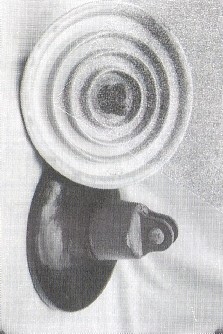 |
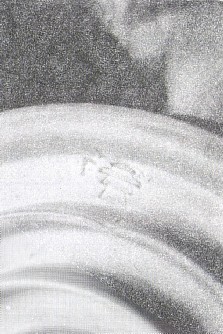 |
|
Bluish-gray and reddish brown suspension disks with large Victor insulator
logo. |
Close-up of large insulator logo marking with VICTOR R=
oo. |
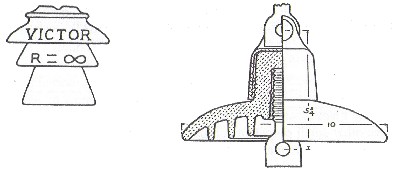
Early 10-inch suspension insulator from the 1910 Locke catalog.
In the November 1998 issue of CJ, we reported a brown U-58 with an embossed
(raised) "5" at the top of the pinhole. Bruce Reigle (NIA #6598)
reported two more styles with the embossed "5" marking. The first
insulator is a white U-52 with a plain or unstylish "5" (see
illustration). Bruce's other insulator is a U-48 with a mottled mahogany brown
glaze. The "5" in this insulator is more stylized (see illustration)
and matches the one on U-58. Needless to say, all three insulators were made of
dry process porcelain. Bruce said he found both insulators at the 1998
Williamsburg National show for $1 each. I'll bet a lot of us will be looking in
pinholes at the next National show.
 |
 |
|
Plain embossed " 5" marking found at the top of the pinhole of
a U-52. |
Stylized embossed "5" marking found at the top of the pinhole of a
U-48. |
Bruce also asked about a U-473A cobalt blue insulator he saw recently with an
unusual PP gold leaf marking. I've been remiss in reporting this commemorative
insulator so now is as good a time as any - at least to report what little I
know about it. As you can see in the photo, the commemorative marking is quite
attractive and includes the years 1894 and 1994. The insulator was produced to
commemorate the 100th anniversary of Porcelain Products Company in Carey, OH. I
don't know how many were made but collectors have managed to get several of
them. At one time you could call the factory and they would send you one in the
mail. My effort to obtain one in the manner failed, but I did manage to get one
from a friend.
Porcelain Products had to stretch the truth a bit to claim a
100th anniversary in 1994. Much of the family tree is shown in Jack Tod's book,
Porcelain Insulators Guide Book. Jimmy Burns (NIA #4032) sent me a rather
detailed family tree that he obtained from Porcelain Products. The predecessor
to Porcelain Products Co. was A. B. Chance. Chance was formed in 1956 when it
obtained Porcelain Products Inc. PP Inc was formed in 1927 from a merger of
about eight small porcelain companies most of which were dry process
manufacturers. One of those, General Porcelain Co., had roots to three other
small porcelain companies one of which was Sun Porcelain Co. Sun was the result
of a earlier merger of five small porcelain companies. One of those small
companies was Brunt Porcelain Co. in East Liverpool, OH.
Brunt started business in 1'894, which gave Porcelain Products Co.
its extended claim to a 100th anniversary. That is a tremendous stretch indeed.
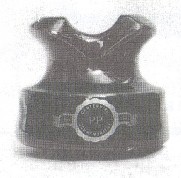
Porcelain Products Co.
commemorative insulator to
celebrate their 100th
Anniversary.
One other company, Victor Insulators Inc., current owners of Fred Locke's
original factory in Victor, NY, also claimed its 100th anniversary in 1994. It
used the more direct lineage of Fred Locke's jobber business, which started
selling glass insulators and electrical goods in 1894. They could have stretched
their lineage back further a year or two or even gone back to Fred Locke's first
patent for CD 289.9 in 1889. All of this effort to claim a 100th anniversary in
1994 was the result of tight competition and a very large electrical trade fair.
Just two examples of how history can be dictated by current competitive
pressure.
| 